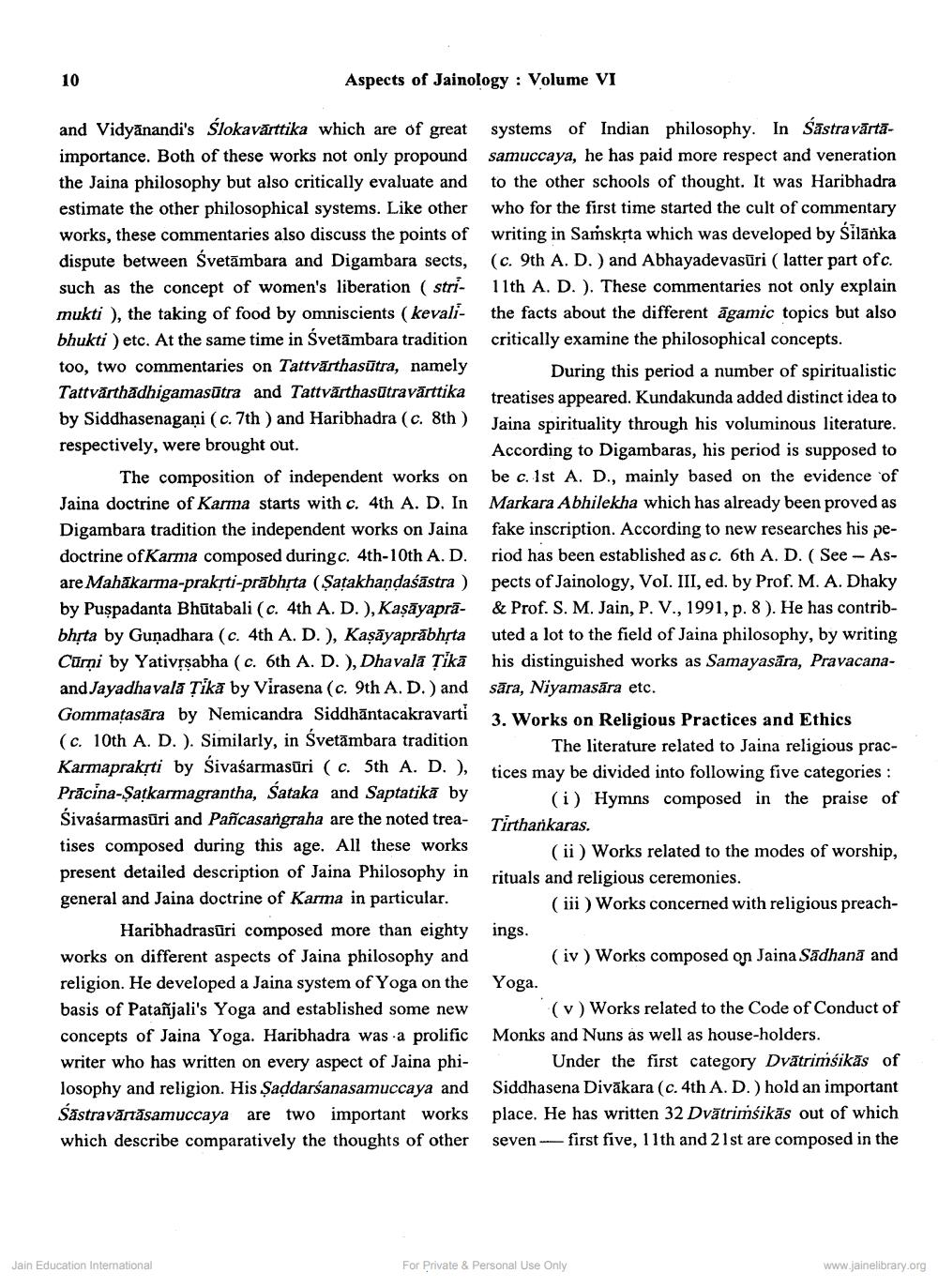Book Title: Jaina Literature form earliest time to century 10th AD Author(s): Sagarmal Jain Publisher: Z_Shwetambar_Sthanakvasi_Jain_Sabha_Hirak_Jayanti_Granth_012052.pdfPage 10
________________ 10 Aspects of Jainology : Volume VI and Vidyānandi's ślokavārttika which are of great systems of Indian philosophy. In Šāstravārtāimportance. Both of these works not only propound samuccaya, he has paid more respect and veneration the Jaina philosophy but also critically evaluate and to the other schools of thought. It was Haribhadra estimate the other philosophical systems. Like other who for the first time started the cult of commentary works, these commentaries also discuss the points of writing in Saṁskṛta which was developed by Silānka dispute between Svetāmbara and Digambara sects, (c. 9th A. D.) and Abhayadevasūri ( latter part ofc. such as the concept of women's liberation ( stri- 11th A. D. ). These commentaries not only explain mukti ), the taking of food by omniscients ( kevali- the facts about the different āgamic topics but also bhukti ) etc. At the same time in Svetāmbara tradition critically examine the philosophical concepts. too, two commentaries on Tattvārthasūtra, namely During this period a number of spiritualistic Tattvärthadhigamasūtra and Tattvārthasūtravārttika treatises appeared. Kundakunda added distinct idea to by Siddhasenagaņi (c. 7th ) and Haribhadra (c. 8th ) Jaina spirituality through his voluminous literature. respectively, were brought out. According to Digambaras, his period is supposed to The composition of independent works on be c. 1st A. D., mainly based on the evidence of Jaina doctrine of Karma starts with c. 4th A. D. In Markara Abhilekha which has already been proved as Digambara tradition the independent works on Jaina fake inscription. According to new researches his pedoctrine of Karma composed duringc. 4th-10th A. D. riod has been established as c. 6th A. D. (See - Asare Mahākarma-prakịti-prābhịta (Şatakhandaśāstra ) pects of Jainology, Vol. III, ed. by Prof. M. A. Dhaky by Puspadanta Bhūtabali (C. 4th A. D.), Kaşāyaprā- & Prof. S. M. Jain, P. V., 1991, p. 8). He has contribbhỉta by Gunadhara (c. 4th A. D.), Kaşāyaprābhịta uted a lot to the field of Jaina philosophy, by writing Cūrņi by Yativrsabha (c. 6th A. D. ), Dhavala Țikā his distinguished works as Samayasāra, Pravacanaand Jayadhavala Țika by Virasena (c. 9th A. D.) and sāra, Niyamasāra etc. Gommatasāra by Nemicandra Siddhāntacakravarti 3. Works on Religious Practices and Ethics (c. 10th A. D.). Similarly, in Svetāmbara tradition The literature related to Jaina religious pracKarmapraksti by Sivaśarmasüri ( c. 5th A. D.), tices may be divided into following five categories : Prācina-Şatkarmagrantha, Sataka and Saptatika by (i) Hymns composed in the praise of Sivašarmasūri and Pancasangraha are the noted trea- Tirtharkaras. tises composed during this age. All these works (ii) Works related to the modes of worship, present detailed description of Jaina Philosophy in rituals and religious ceremonies. general and Jaina doctrine of Karma in particular. (iii) Works concerned with religious preachHaribhadrasūri composed more than eightyings. works on different aspects of Jaina philosophy and (iv) Works composed on Jaina Sadhanā and religion. He developed a Jaina system of Yoga on the Yoga. basis of Patañjali's Yoga and established some new (v) Works related to the Code of Conduct of concepts of Jaina Yoga. Haribhadra was a prolific Monks and Nuns as well as house-holders. writer who has written on every aspect of Jaina phi- Under the first category Dvātrimsikās of losophy and religion. His Şaddarsanasamuccaya and Siddhasena Divākara (c. 4th A. D.) hold an important Săstravārāsamuccaya are two important works place. He has written 32 Dvātrimsikäs out of which which describe comparatively the thoughts of other seven - first five, 11th and 21st are composed in the Jain Education International For Private & Personal Use Only www.jainelibrary.orgPage Navigation
1 ... 8 9 10 11
